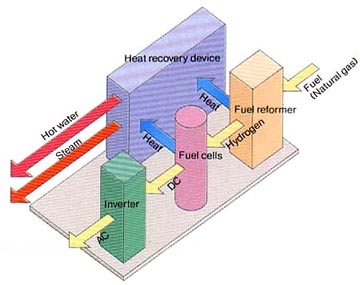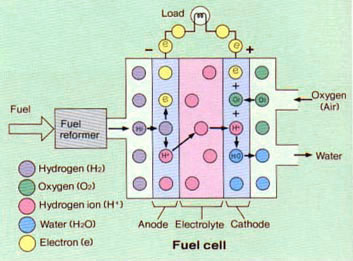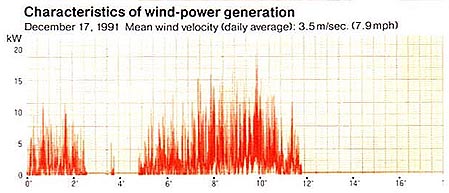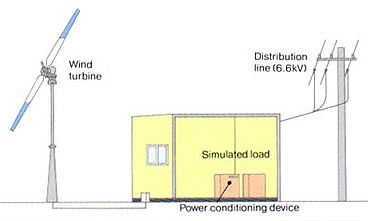| |
|
Different type of energy:
Wind Energy
Solar Energy
The Holone
| Fuel Cells - Electrochemical Power Generation |
| Fuel cell power generation systems are highly efficient
in converting fuel into electricity, and their overall energy efficiency
is optimized when the heat generated by the reaction is utilized for space-conditioning
and hot water supply. Despite these attractive features, the fuel cells
developed so far have a relatively short life of about five years, and
thus current research efforts focus on extending their service life to
allow wider applications.
Fourteen 50-kilowatt and one 200-kilowatt phosphoric acid fuel cell
systems have been installed at the Rokko test site. Natural gas is used
as the fuel. The target efficiency of the fuel cells is 40%, as the heat
is not recovered for utilization in this project. |
 |

The principle of the fuel cell
Fuel cell systems generate electricity through electrochemical reactions
between hydrogen and oxygen by the reverse process of water-electrolysis,
producing very little pollutants and noise, and thus minimizing environmental
impact.
The vital reaction in the cell occurs when hydrogen molecules in the
fuel gas separate into hydrogen ions and electrons at the anode (fuel electrode).
The electrons leaving the anode do work en route to the cathode (oxygen
electrode). At the cathode, oxygen, hydrogen ions and electrons join to
form water. DC electricity is converted to AC electricity for practical
use. |
 |
| Wind energy
- Putting the wind to work |

| Wind-generated power is one of the most promising
methods of harnessing renewable energy resources. Wind turbine generators
burn no fuel and are environmentally benign. However, wind is temperamental
and consequently so are wind turbines. Thus, unless located in areas of
constantly high winds or otherwise linked with existing power grids, wind
power systems cannot be depended upon to provide a stable supply.
Two grid-connected wind turbine generators have been installed at the
Rokko site. Both are of the downwind type and are capable of producing
16.5 kilowatts each at a rated wind speed of 8m/sec (18mph). The cut-in
speed, or the minimum wind speed at which a generator output occurs, is
3.5m/sec (7.9mph). The 15m diameter double-bladed rotors are designed to
rotated at a rated speed of 81.5 rpm, and to yaw freely in winds from any
direction. To regulate the speed of the rotors, a mechanical pitch-governor
is used on each unit.
|

Wind turbine generators with power
conditioning
equipment and simulated loads.
|
 |
Wind energy conversion
The wind turbine converts the energy of the wind to turning force.
The turning force is transmitted by gears form the turbine axis to teh
induction generator to produce AC electricity. Power conditioning equipment
is used to convert the AC output first to DC and then to AC electricity
of a desired frequency and voltage. |
| Solar Energy | Fuel
Cells | Wind Energy | The
Holone | Home | Case
Study Index |
|



